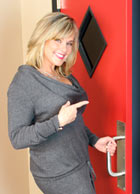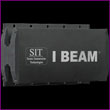Soundproof Rooms
Home » Soundproof Rooms
Floor Soundproofing |
Soundproof Walls |
Soundproof Doors |
|
 |
 |
 |

These products are proudly
|
Soundproof Room Basics - Call Toll Free 866-243-1001 for Details & Pricing
Click here for a detailed guide on soundproofing and the materials needed (pdf).
It is important to plan ahead if you want to keep sound from getting out of a new room setting, as the process to isolate the room must be done as construction begins - it's best to install Sound Isolation Products before any wall framing has begun. While we can work with rooms with existing framing in place, there is a noticeable drop in performance in these situations. Please contact us, or call #866-243-1001 toll free regarding your room and we will be happy to work with you to find the best sound isolation solution for your setting. Improvements in Room Acoustics, however, are done after the room is completed with our Fabric Walls, Acoustic Panels, Seating Riser Bass Traps and 4" Acoustic Front Walls. Room Acoustics, or Room Tuning, which makes the room sound great, is quite a different process than Sound Isolation, which keeps sound in.
Room Isolation Basics – The 3 most
important issues:
(Related products and specifics are listed on the pages linked to above)
Floor Isolation. The first issue to deal with to isolate a room from other room areas in a home is floor-borne vibration. As sub-woofers usually sit directly on the floor, in addition to main speakers also being located there, this is a major source of sound transmission to other rooms through the framing structure. Wood floors are good sound transmitters, but you would be surprised at how much sound concrete can transmit, as well. Carpeting helps some, but in order to both quiet the floor and also de-couple it from the wall framing, Sound Control Floor Underlayment, such as our Quiet Floor mats, is required. This helps stop energy from getting into the studs, which will stop sound transmission not only to adjacent rooms, but also to areas above the room. The entire floor, especially under the wall framing, needs underlayment treatment.
Framing Isolation. The next issue involves studs and the sound they transmit through your room’s framing. Both the floor below the studs, as well as the wallboard attached to it transmit sound through the studs, which are then transmitting vibration to other room areas. If you deaden the studs, you will stop sound from not only being sent to adjacent room areas, but also from travelling up through the ceiling. Using our Resilient Sound Isolation Clips is a very effective method of controlling sound travelling through walls, as well as up through ceilings to stop it from travelling to rooms above.
Wallboard Isolation. The last important issue to deal with is sound vibration picked up by the room’s wallboard – both walls and ceilings. Wallboard acts like a microphone, picking up sound vibrations in one room, then transmitting through the attached studs in the framing. The attached wallboard on the other side of the room then “picks up” the sound vibration transmitted through the studs and acts as a loudspeaker, sending the sound vibration into adjacent rooms. Using Soundbreak XP drywall with the sound isolation clips is highly effective in stopping sound transmission. While the Soundbreak XP product cost is higher than using double drywall with green glue in between, when labor is factored in, it is a less expensive option, with the best soundproofing performance that we can recommend.



